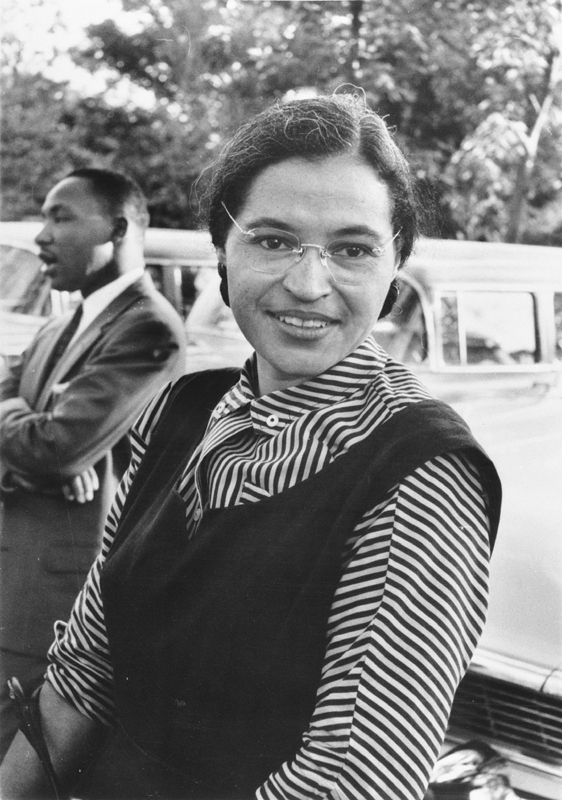Winner of the Fall 2016 StMU History Media Award for
Best Article in the Category of “People”
When one hears the name Rosa Parks, one is taken back in time to 1955, when a brave woman decided not to give up her seat. Rosa Parks was a woman who believed that the color of a person’s skin should not dictate the way a person is treated. Rosa Parks was a civil rights activist.

James McCauley, a skilled carpenter and stonemason, and Leona McCauley, a school teacher, were married on April 12, 1912, in Tuskegee, Alabama. Two months before their first anniversary, on February 4, 1913, in Tuskegee, Alabama they welcomed a daughter into their lives and named her Rosa Louise McCauley. On August 20, 1925 the McCauleys welcomed their son, Sylvester McCauley, into their family.1 The McCauley family decided to move to Abbeville, Alabama where they lived with James’s parents, sharing a bedroom with a large extended family. Rosa’s mother grew tired of the living arrangements and without her husband James around to support the family, she made the decision to leave. In 1917, when Rosa was only 4 years old, Leona took her two young children and moved back to Pine Level, Alabama where she and the children stayed with her parents. Rosa saw her father a year later when she was five and then again when she was an adult and married.2
Rosa received most of her education from her mother and grandfather as a little girl. In 1924, when Rosa was eleven years old, her mother enrolled her in the Montgomery Industrial School for Girls. The school was for African American girls seeking education; they were taught by mostly white teachers. The school focused on the domestic sciences of cooking, sewing, and housekeeping. The white people of the town accused the teachers of teaching racial equality and referred to them as Yankee black lovers. The school was later burned down by the Ku Klux Klan as they grew more powerful.3 After the Montgomery Industrial School for Girls closed in 1928, fifteen year old Rosa attended Booker T. Washington High School for her ninth grade year. She wanted to be a teacher just like her mother, so for her tenth grade year Rosa attended Alabama State Teachers College for Negros. Sadly, she had to drop out of school and return to Pine Level, Alabama to care for her grandmother who had grown ill. When her grandmother died in 1929, Rosa was only 16 years old. She moved back to Montgomery and found her first job making men’s blue denim work shirts at a textile factory. Soon after beginning her job in the factory, Rosa was forced to leave in order to care for her mother who had also grown ill.4 Rosa spent her teenage years cleaning houses and taking in sewing jobs. In 1931, Rosa met Raymond Parks, who worked as a barber and was a member of the National Association for the Advancement of Colored People (NAACP).5 The two fell in love and in December 1932, Rosa and Raymond were married. Raymond encouraged his new bride to go back to school so as to finish her education. This meant so much to her, and so Rosa completed her studies and received her high school diploma in 1934.6

By 1943 all buses in the South had long been segregated and had followed an extensive set of rules set forth by the bus drivers. Montgomery, Alabama was no exception to the segregation. All the buses had thirty-six seats; the first ten were reserved for whites only, ten seats in the back of the bus were for African Americans, and as for the sixteen seats in-between, these were for the bus drivers to decide. African Americans were frequently forced to give up their seats for whites and the bus drivers imposed their own segregation rules through the use of guns they carried with them.7
In November of 1943 Rosa boarded a bus in Montgomery, Alabama. African Americans were typically required to enter the bus from the doors located near the back of the bus, but since the bus was extremely crowded, Rosa was forced to enter from the front doors of the bus. The bus driver demanded she get off the bus and enter through the back door and Rosa refused, standing her ground and explaining to the bus driver that since she was already on the bus there was no need for her to get off because the back of the bus was already at capacity and she would not be able to enter from the back. The bus driver began tugging at Rosa’s coat to push her off the bus and so she decided to not create more of a scene and exited the bus.8
On December 1, 1955, Rosa headed to work at the Montgomery Fair Department Store on the Cleveland Avenue bus to Court Square. It was a normal day for Rosa, working her regular shift, busy as usual.9 Once work was over, Rosa was tired; her body ached, her feet hurt and were swollen from standing all day. Rosa walked to Court Square to wait for her bus and as soon as the first bus came, she saw that it was packed and decided to wait for the next one. Once the second bus arrived Rosa entered the bus, paid, and sat in the racially neutral middle section behind the movable sign which read “colored.”10 At the third stop, a group of whites entered the bus and since the last front seats were taken, one was left standing. The bus driver turned around and looked at Rosa. Rosa was shocked to see that it was the same bus driver she had had a problem with twelve years earlier. The driver, James F. Blake, began to shout at the passengers, “Move ya’ll, I want those two seats,” meaning he wanted Rosa to give up her seat. Rosa did not get up and Blake went straight to Rosa demanding she give her seat up. When Rosa still would not comply he warned her that he would have her arrested, to which she simply replied, “You may do that.”11
Once police arrived, Rosa was arrested, handcuffed and taken to the police station. At the station, Rosa was finger printed, photographed and placed in a cell. While in jail Rosa was treated badly. She requested a drink of water and a police officer yelled out to her “for whites only.” She even requested to make one phone call and was ignored. After requesting several times to make her phone call, she was finally given approval and she phoned her husband. Edgar Daniel Nixon, an African-American civil rights leader, paid a one-hundred dollar bond to bail Rosa out of jail. Rosa worked with Nixon as a branch secretary. In speaking with Nixon about the incident, Rosa decided to file suit and make a civil rights case regarding Montgomery’s bus segregation.12 On the day of trial, December 5, 1955, African Americans in Montgomery boycotted the buses and Rosa was found guilty of breaking segregation laws.13 The boycott proved to be a large protest, and it led to the formation of the Montgomery Improvement Association (MIA).14 On November 13, 1956, the Supreme Court ruled that bus segregation was unconstitutional and the boycott ended on December 20, 1956.15 Rosa became known as the mother of the Civil Rights Movement.16

Rosa Parks traveled and supported civil rights events and causes and even wrote an autobiography, “Rosa Parks: My Story.” In 1999, for all her accomplishments and beliefs as a strong African American, Rosa was awarded the Congressional Gold Medal, which is the highest honor in the United States presented to a civilian.17 On October 24, 2005, at the age of 92, Rosa Parks passed away. She became the first woman in the nation’s history to lie in state at the U.S. Capitol.18
Rosa Parks left a major impact on America and made history. She stood up for what was right for herself and for the people, not because of the color of their skin but because she believed that everyone should be treated equally. She boarded a bus at the end of a long work day, tired and wanting to go home, not realizing that she would forever change segregation in America. Rosa Parks was a very noble woman and she left behind a legacy that will never be forgotten.
- Salem Press Biographical Encyclopedia, January 2016, s.v. “Rosa Parks,” by Tammy K. Baggett. ↵
- Douglas Brinkley, Rosa Parks (Penguin Group Penguin Putnam Inc., 2000), 20-21. ↵
- Brinkley, Rosa Parks, 28, 29, 36. ↵
- Brinkley, Rosa Parks, 36. ↵
- Brinkley, Rosa Parks, 38. ↵
- Salem Press Biographical Encyclopedia, January 2016, s.v. “Rosa Parks,” by Tammy K. Baggett. ↵
- Brinkley, Rosa Parks, 57. ↵
- Brinkley, Rosa Parks, 58-59. ↵
- Salem Press Biographical Encyclopedia, January 2016, s.v. “Rosa Parks,” by Tammy K. Baggett. ↵
- Brinkley, Rosa Parks, 105. ↵
- Brinkley, Rosa Parks, 106-107. ↵
- Brinkley, Rosa Parks, 73, 108, 109, 111, 113, 114. ↵
- Brinkley, Rosa Parks, 152. ↵
- Brinkley, Rosa Parks, 134. ↵
- Brinkley, Rosa Parks, 152, 170. ↵
- Rosa Parks: “The First Lady of Civil Rights,” Bill of Rights Institute, March 2, 2012, http://billofrightsinstitute.org/rosaparks/. (accessed November 7, 2016). ↵
- Salem Press Biographical Encyclopedia, January 2016, s.v. “Rosa Parks,” by Tammy K. Baggett. ↵
- Salem Press Biographical Encyclopedia, January 2016, s.v. “Rosa Parks,” by Tammy K. Baggett. ↵




79 comments
Mariana Sandoval
I think it’s great that her husband encouraged her to go back to school knowing that it was something that she had wanted to do since she was younger.
It’s terrible that throughout our history, people were denied an education (in regards to Rosa’s school getting burned down because the Klan didn’t like the idea of blacks being educated).
I thought the flow of your article was great. Every detail you included painted a really great picture about the person she was and why she did what she did.
Aaron Jaramillo
Great article and background information on Rosa Parks. I have always only known her for her not giving up her seat but the information about her perseverance to become educated was great information. She is a great example of how simply doing what is right and standing up for what is right made such a lasting impact on this country. She was the start to letting everyone know that no matter what color, race, religion, or social status someone is, we are all equal. We are all humans and deserve to be treated the same.
Joshua Tinajero
it is amazing to hear about one person actions in the hopes of creating change for a whole country. It takes a special kind of person to stand against law and societies norms, she is truly a unique individual. Great Article Aurora!
Amanda Cantu
Great article! Everyone should know who the famous Rosa Parks is but it was really interesting to read about her history. We all know what she did and I admire her for standing up against it. I never knew anything else about her other than what she is known for so I really enjoyed reading her background. Keep up the good work!
Maranda Avina
Great job! I really enjoyed reading this article, there was a lot of good information and detail put into it. In school all I ever knew about Rosa Parks is the she refused to give up her seat and became the mother of the Civil Rights Movement. I had no idea about the extent of her actions and how great of an impact she really was. Awesome article.
Andres Palacios
Excellent article about Rosa Parks one of the most influential women to fight for not only women’s rights but also for all African Americans. Even after being deprived of her rights she stood up for her believes and her rights. Today she is a hero, who has encouraged people to fight for their rights and injustice. Very well written article.
Angelica Espinoza
Wow! I really enjoyed this read. This article is such a great, in-depth exploration of such an important figure in a fairly recent time in our history. Great job with all of the details, this is exactly the type of work I’d expect when I think of an explanatory text. Looks like you also did a lot of research, which is what enabled you to write such a strong article! Awesome job, she deserves all the recognition she gets.
Desmond Bonsignore
This was a very detailed article! I was able to learn a lot of information about Rosa Parks before she became the civil rights activist that most people know her as. Her early life seemed very challenging, which makes sense as to why she grew up into the strong woman who would not give up her spot on the bus. Very informative article!
Jeanette Wimberly
Very well written! I like how you showed who Rosa Parks was before the bus incident, as many just know about her life after her refusal to give up her seat. It was interesting to learn how her husband was so encouraging about her education! Thank you for capturing the importance Rosa Parks had not only for Civil Rights Movement, but for generations of African Americans to come.
Alyssa Almaguer
Great article on a very important woman in our history! I never knew the real story of her not giving up her sea; I had no idea the bus drivers dictated who sat where. She continues to be an inspiration.